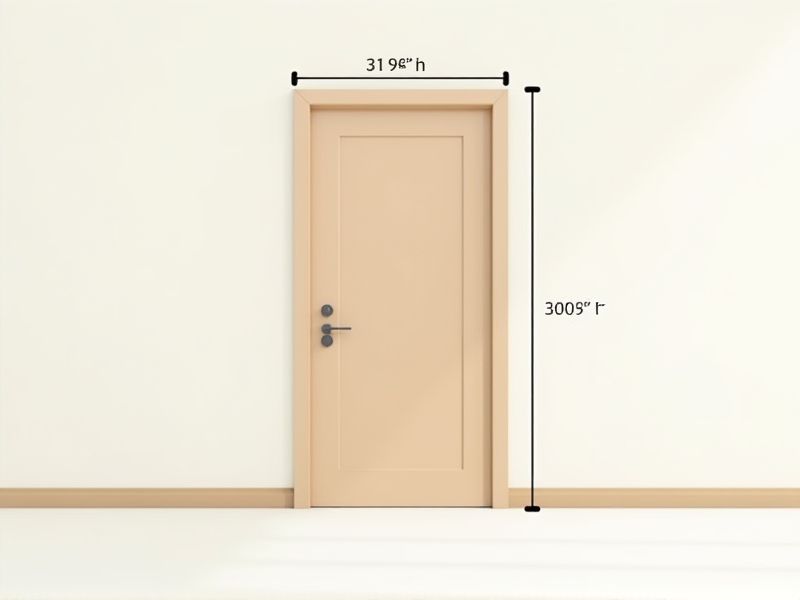
When selecting an interior door, knowing the standard dimensions can help you plan for a proper fit and smooth installation. Most interior doors in residential homes are 80 inches tall (6 feet 8 inches) and 30 to 32 inches wide, though widths can range anywhere from 24 inches for closets to 36 inches for more accessible entryways. The standard door thickness is typically 1 3/8 inches. Always measure your existing opening before purchasing, as some older or custom homes may require non-standard sizes.
Height: 80 Inches
The standard height for interior doors typically measures 80 inches, designed to accommodate the average ceiling height of residential spaces. This height ensures sufficient clearance for most individuals, allowing easy access while maximizing aesthetic appeal. Additionally, you may encounter variations, such as 78 inches or 84 inches, to suit specific architectural needs or personal preferences. When selecting an interior door, consider this standard height as a crucial factor in achieving both functionality and style in your home.
Width: 32 Inches
A standard interior door typically has a width of 32 inches, making it suitable for most residential spaces. This width allows for easy accessibility, accommodating furniture movement and ensuring comfortable passage for individuals. In many homes, this size may also comply with building codes that emphasize accessibility for all occupants. When selecting a door, consider the overall height, which usually measures around 80 inches, complementing the 32-inch width for a standard fit in door frames.
Thickness: 1 3/8 Inches
The standard thickness for interior doors is typically 1 3/8 inches, ensuring a balance between sturdiness and weight. This thickness is ideal for residential settings, providing adequate sound insulation and durability for everyday use. Many interior doors, such as hollow-core and solid-core, are designed around this standard, making them suitable for various styles and applications. Choosing a door with this thickness can enhance the overall aesthetic and functional integrity of your living spaces.
Frame Clearance
Frame clearance for interior doors typically ranges from 1/8 inch to 1/4 inch on both the top and sides. This clearance ensures proper operation, allowing doors to open and close smoothly without obstruction. A standard door frame height measures 80 inches, with widths usually between 24 to 36 inches, depending on design and function. Ensuring accurate frame clearance can prevent potential issues such as door binding or improper sealing, enhancing overall performance and longevity of the door.
Hinge Placement
Hinge placement on interior doors is critical for ensuring optimal functionality and aesthetics. Standard configurations typically involve positioning hinges 7 inches from the top of the door and 11 inches from the bottom, with a third hinge added for doors exceeding 6 feet 8 inches. Proper alignment facilitates smooth operation, preventing door sagging and wear over time. For your projects, consider using door hinges rated for at least 100 pounds to accommodate typical interior door weights.
Swing Direction
The swing direction of interior doors significantly influences both functionality and space management within a room. Doors can swing inward or outward, with typical measurements indicating a standard width of 24 to 36 inches. Choosing the correct swing direction ensures optimal flow and accessibility, particularly in smaller spaces where every inch counts. When selecting a door, consider how the swing will affect furniture layout and ease of movement, helping you create a harmonious living environment.
Handle Height
The standard handle height for interior doors typically ranges from 34 to 48 inches above the floor, depending on the door's design and purpose. For residential settings, a commonly recommended height is 36 inches, which ensures accessibility for most adults. In commercial buildings, ADA compliance requires that door handles be installed at a height of no more than 48 inches to accommodate individuals with disabilities. When choosing your door handles, consider ergonomic designs that enhance comfort and usability for all users in your space.
Interior Clearance
Interior doors typically require a minimum clearance of 2 inches from the floor to accommodate carpets and ensure smooth operation. The standard width for residential interior doors ranges from 24 to 36 inches, catering to varying room sizes and accessibility needs. A common height for these doors is 6 feet 8 inches, accommodating the majority of ceiling heights in homes. To achieve optimal functionality, it's essential to consider the door's swing direction as well, ensuring it integrates well within your space.
Door Weight
The standard interior door typically weighs between 25 to 50 pounds, depending on its material and design. Solid core doors, often composed of a dense wood or composite material, generally weigh more, ranging from 35 to 50 pounds, providing enhanced sound insulation and durability. In contrast, hollow core doors, commonly made with a lightweight frame and a cardboard honeycomb interior, usually weigh around 25 to 35 pounds, making them easier to install. Choosing the right door weight is essential as it affects installation, functionality, and even the aesthetic appeal of your interior space.
Material Type
Interior doors are primarily made from several material types, each offering distinct benefits and aesthetics. Solid wood doors, commonly ranging from 1 3/8 inches to 1 3/4 inches thick, provide durability and sound insulation, while styles like oak or maple add a touch of natural beauty. Hollow core doors, typically around 1 3/8 inches thick, consist of a cardboard or polystyrene core and are lightweight, making them economical and easy to install. Alternatives such as fiberglass or steel doors are also available, offering increased durability and resistance to moisture, making them suitable for various interior applications.
